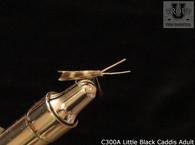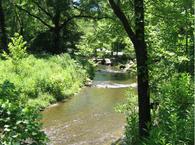In this class the student will learn:
First why practice Catch and Release? We have the ability to kill or not to kill a trout when we catch it. There is nothing wrong to keep a fish for the table once in awhile. But, when fishing in high pressured areas where you know a number of other anglers will be fishing, it is good to recycle the trout for other anglers to enjoy catching. Also, sometimes it is the law such as the case with delayed harvest regulations. If you decide to keep any of the trout that you catch, it is better to keep the stocked trout leaving the wild trout to reproduce. Remember it only takes a few spawning fish to restock a stream in two or three years.
Studies have shown that the survival rate for C&R when done properly is between 95% and 99%, (depending on which study you see) so you need not feel guilty about catching and releasing the trout. We will now start learning how we can achieve the upper range of that study.
Where you fish is important if you intend to C&R. You should start by choosing a stream that is clear. Sediment will hamper the fish to “breath” after it is caught. Also, the trout need oxygenated water to live and that is especially important when the trout is stressed after being caught. Stress will increase the lactic acid level in the trout’s muscles which will cause the trout to tire easily. Therefore, do not practice C&R when the water temperature is above 70 or 72 degrees maximum as the survival rate will be impaired. Fish caught in moderate water or slow water is more prone to survive than those caught in swift water.
The next thing to consider is the tackle. Always use a single hook fly or lure, and a barbless hook is preferred for reasons that we will discuss later in the class. When using a tippet, use the strongest possible and still be able to fool the trout. Do not use a 7X tippet especially in high water. The correct tippet will permit a fast retrieve of the fish without excessive playing of the fish. Always keep the drag set properly to avoid breaking the line and to avoid the necessity of playing the trout too long.
How you play the fish is important. Obviously, you will want to land the trout as quickly as possible avoiding the over stressed condition. Do not increase the playing time for the purpose of photographing the event. Steer the fish toward an area of clear water, not muddy water or water clouded with sediment that has been stirred up by your boots. Gently running clear shallow water without rocks that can damage the trout is preferred. Finally use a knot-less landing net whenever possible.
When handling the trout, squeeze the trout just ahead of the tail while holding it upside down with pressure applied from the top to the bottom of the trout. This pressure will mesmerize the trout as long as it is not applied from side to side. It is best to keep the trout out of the water as little as possible. Using the barbless hook will allow the trout to shake off the hook without the angler touching the trout. Often times, the hook can be backed out of the trout’s mouth without the trout ever coming out of the water. The best approach to handling the trout is to keep it in the water as much as possible. The air pressure is different than the water pressure that it is accustomed to, so time out of the water can damage the internal organs of the trout.
If you must take the trout out of the water, be sure to wet your hands before you touch the trout. This will protect the slimy mucus membrane on the trout. This membrane is important to protect the trout from fungal or bacterial infections. Always, have forceps or needle nose pliers handy to retrieve the hook if it deeper into the trout’s mouth. Also, they can be used to remove two of the treble hooks and to flatten the barbs on hooks.
Returning a trout to the water is important. Place it gently into the water facing upstream and gently move it back and forth all the while keeping it facing upstream. This will get the water circulating in the gills and will provide the trout with much needed oxygen. At this point, they will usually scoot away in a hurry looking for a cool place to rest such as a large rock. If the fish is not active and tends to go “belly up” or turns on it’s side or sinks to the bottom, do not despair. Just grab the fish gently and move it back and forth some more or poke it gently with your rod tip or with the handle of the net. A slight motion will normally “jump start” the trout into normal activity.
Photographing the fish is something that we all want to do so be careful how you go about it. Decide if you want to take a picture while you are still playing the fish and plan the shot while you are still playing the trout. Have a buddy handy with the camera and be sure that the buddy is familiar with the camera. Do not expect that buddy to learn the camera while the fish is out of the water.
Next, consider the pose. It is best to take a picture with the fish half out of the water being cradled by the angler. It offers a pleasant natural setting and makes it easier on the trout. It is a good idea to turn on the fill flash and take several rapid pictures so you can choose the best one later. If the picture takes too long, place the trout in the water to be refreshed before commencing. The classic hero shot with the head up and the tail down is a good way to injure the internal organs and to increase the mortality rate.
These may seem like too many directions to remember, however, with practice, they quickly become second nature to the angler.
For a much greater detailed discussion about C&R, go to the podcast Proper Catch Release Techniques by Tom Rosenbauer
Please review the Top 5 Tips for C & R.
Here is a site worthy of further review;





